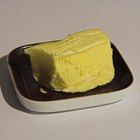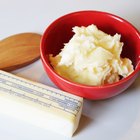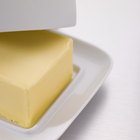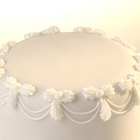
Whipped butter makes for a softer, easier spread. When mixed with air, the butter can increase in volume by as much as a third, yet it still may contain 80 percent butterfat. Adding cold water makes the whipped butter even smoother and adds additional volume. It also creates a lighter butter. Usually, ice water works best when whipping, as it keeps the butter cool during mixing.
Whipping
A large bowl and a whisk is all you need to make homemade whipped butter. A food mixer makes the process even faster. The National Dairy Council suggests creaming softened butter in a food processor, pulsing at low speed. Eventually, the butter will turn light and fluffy, as the air is trapped inside. Adding cold water to whipped butter involves slowly mixing one half cup of iced water to the whipped butter and continuing to whip, until it fluffs up.
Usage
Adding cold water to whipped butter gives a smoother finish. However, because the water is released as the butter warms up, it is not suitable for spreading on hot toast, for example. Instead, it's perfect for cold bread rolls. Because the density of whipped butter is different from standard butter, you should not use it in baking or cooking recipes, as the measurements will be inaccurate. It also melts too fast and froths too much for frying.
Making Butter
Making butter at home from heavy cream can also require cold water. After mixing the cream slowly, it will form clumps of butter granules. Once you drain off the buttermilk, some recipes suggest that you combine the butter with ice-cold water and mix firmly. This helps rinse off more buttermilk, leaving a pure butter. Once finished, you can make this into whipped butter by whisking vigorously.
Considerations
Whipped butter generally goes rancid more quickly than standard butter. Whipped butter mixed with cold water is even more unstable, and won't keep in the refrigerator as long as a solid butter pack. If you make whipped butter with water, do so shortly before use. When it comes to whipped butter, the fresher the better.
Related Articles

Softened vs. Melted Butter When Baking

Can I Substitute Coconut Milk for ...
How Long Can You Keep Butter ...

How to Store Ghee

Does Whipped Butter Have to Be ...

Is Homemade Butter Better Than ...

How to Quickly Thaw Butter

How to Store Butter

How to Cream Butter Without a Mixer
How Long Can Unsalted Butter Go ...

How to Make Light & Fluffy Whipped Body ...

Why Does Cream Turn Into Butter?

How to Use Shortening Instead of Oil ...

What Can I Substitute for Butter When ...

Does Butter Harden After It's Melted?

Why Can't You Use Ultra Pasteurized ...

Can I Use Melted Margarine in Cake Mix ...

How to Make a White Decorator Icing

Avocado Butter Hair Treatment

How to Melt Hershey's Chocolate
References
Writer Bio
Based near London, U.K., Peter Mitchell has been a journalist and copywriter for over eight years. Credits include stories for "The Guardian" and the BBC. Mitchell is an experienced player and coach for basketball and soccer teams, and has written articles on nutrition, health and fitness. He has a First Class Bachelor of Arts (Hons.) from Bristol University.
Photo Credits
Comstock/Comstock/Getty Images